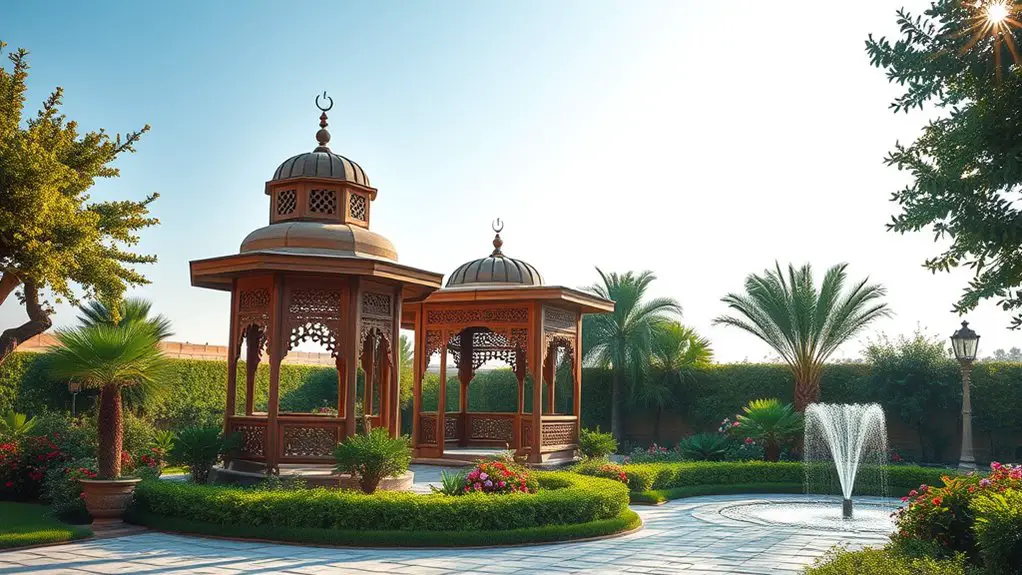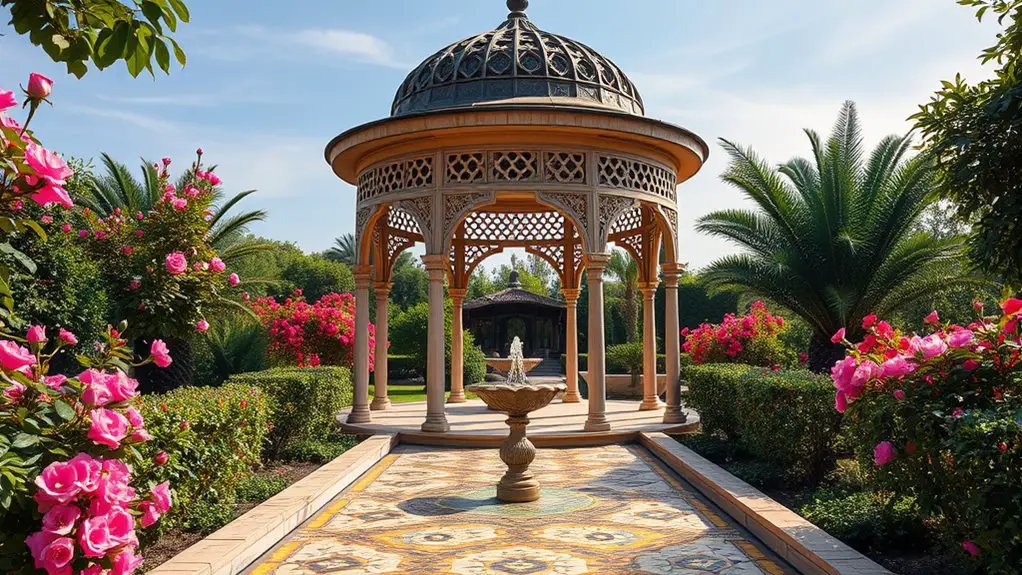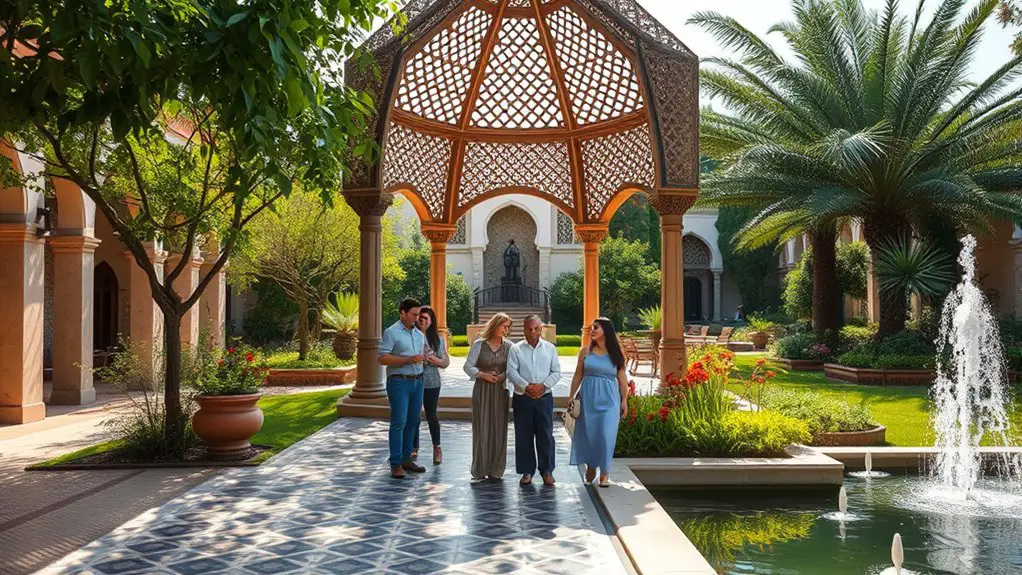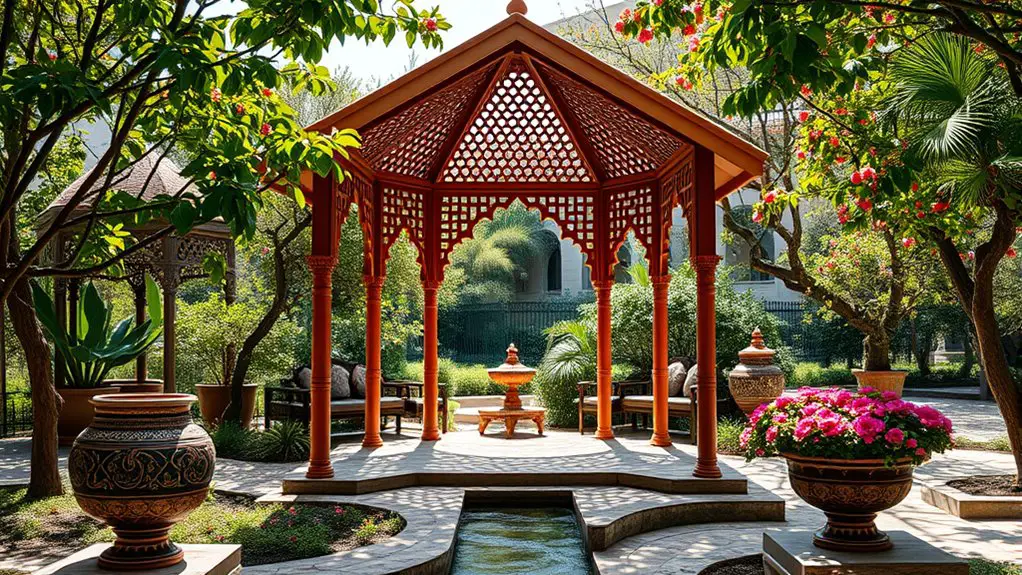Gazebos are essential in Islamic garden design, enhancing both beauty and functionality. They provide structured spaces for contemplation and social interaction, reflecting the harmony between nature and architecture. Their intricate designs and strategic placement encourage tranquility, inviting visitors to connect spiritually and communally. Additionally, gazebos symbolize cultural narratives while adapting to local aesthetics. Understanding their significance reveals deeper insights into how they mold the experience of an Islamic garden. You might be intrigued by the stories behind iconic examples.
Historical Origins of Gazebos in Islamic Gardens

Although gazebos may seem like a modern addition to garden design, their origins in Islamic gardens trace back to the rich cultural and architectural traditions of the Islamic Golden Age. You’ll find that these structures were influenced by various historical factors, including Persian and Moorish aesthetics, which emphasized harmony between nature and architecture. The design evolution of gazebos reflects a blend of functionality and beauty, serving both as contemplative spaces and social gathering spots.
These structures often utilized intricate geometric patterns and lush materials, embodying the Islamic principles of balance and tranquility. As you explore Islamic gardens, you’ll notice how gazebos facilitate a dialogue between the outdoor environment and human experience. The historical influences that shaped these architectural gems demonstrate their significance in creating serene retreats, allowing individuals to connect deeply with their surroundings while enjoying the freedom of open-air contemplation.
Architectural Features of Islamic Gazebos
As you explore the architectural features of Islamic gazebos, you’ll discover how their design reflects a profound understanding of symmetry, light, and space. These structures often showcase intricate ornamental details, from geometric patterns to arabesques, which not only enhance their aesthetic appeal but also embody cultural significance. The structural design of Islamic gazebos typically emphasizes balance, with central domes or arches that draw the eye upward, creating an illusion of expansiveness.
Moreover, the strategic use of open spaces and shaded areas allows for a seamless integration with the surrounding gardens, promoting a sense of tranquility. Materials like stone, wood, and tile are employed not just for durability but also for their ability to interact with light, casting enchanting shadows that change throughout the day. Overall, Islamic gazebos exemplify a harmonious blend of artistry and functionality, inviting you to experience their beauty in a serene setting.
The Symbolism of Gazebos in Islamic Culture

The architectural beauty of Islamic gazebos transcends mere aesthetics; it embodies rich symbolism within Islamic culture. These structures serve as more than just shaded retreats; they represent a convergence of various cultural representations and beliefs. For you, understanding this symbolism can deepen your appreciation of their role in gardens. Gazebos often symbolize paradise, reflecting the Islamic ideal of a serene, harmonious environment. The intricate designs and geometric patterns reflect the divine order, while the open structure invites connection with nature, emphasizing the importance of balance and tranquility. Additionally, gazebos act as focal points within gardens, guiding visitors through a journey of contemplation and communion. Their presence often signifies community, offering a space for gathering and sharing stories. Hence, the symbolic meanings embedded in Islamic gazebos highlight their significance, revealing layers of cultural richness that resonate with the ideals of beauty, harmony, and spiritual reflection.
Gazebos as Spaces for Spiritual Reflection
While gazebos in Islamic gardens often serve as picturesque retreats, they also function as profound spaces for spiritual reflection. These structures, strategically placed within lush landscapes, create meditative spaces that invite contemplation and inner peace. Their design, often incorporating intricate geometric patterns and harmonious proportions, fosters a sense of tranquility that enhances the spiritual experience.
In these tranquility zones, you can escape the noise of daily life and connect with your inner self. The ambient sounds of flowing water and rustling leaves further amplify the serene atmosphere, allowing for deeper meditation. Gazebos provide shelter yet remain open to nature, symbolizing an embrace of both the physical and spiritual worlds.
Ultimately, these gazebos serve as sacred havens where you can engage in prayer, reflection, or simply be present in the moment, making them essential elements in the design of an Islamic garden dedicated to spiritual growth.
Enhancing Community Interaction Through Gazebos

When gazebos are integrated into Islamic garden design, they become pivotal in fostering community interaction. These structures offer a welcoming atmosphere for social bonding and community gatherings, making them essential in contemporary urban landscapes. Here are three key ways gazebos enhance community interaction:
- Central Gathering Point: Gazebos serve as an inviting focal point, drawing people together for events, celebrations, or casual meet-ups.
- Facilitating Communication: The open design encourages conversations and connections, breaking down barriers between individuals and fostering a sense of belonging.
- Cultural Exchange: As diverse groups come together in these spaces, gazebos promote cultural sharing and understanding, enriching the community experience.
The Aesthetic Appeal of Gazebos in Garden Design
Gazebos add a distinct charm to garden design, seamlessly blending functionality with beauty. When you consider their aesthetic appeal, think about how they serve as focal points, drawing the eye and creating a serene atmosphere. The choice of color palettes plays an essential role; soft pastels can evoke tranquility, while bold hues can energize the space. Material choices also greatly impact the overall look—wood offers warmth and timelessness, while metal and stone provide a contemporary edge.
Incorporating intricate patterns inspired by Islamic art can further enhance the gazebo’s visual allure, harmonizing with the surrounding flora. The interplay of light and shadow through latticework can create mesmerizing effects, inviting you to relax and enjoy your surroundings. Ultimately, gazebos not only beautify a garden but also foster a sense of peace, making them indispensable in thoughtful garden design.
Integrating Gazebos Into Modern Islamic Gardens
When you consider integrating gazebos into modern Islamic gardens, you’ll notice their dual role as both aesthetic focal points and functional spaces. These structures not only enhance the garden’s visual appeal but also serve as versatile settings for social interaction and contemplation. Furthermore, their historical significance in Islamic culture adds depth to their presence, bridging traditional values with contemporary design.
Symbolism and Aesthetics
As you explore the integration of gazebos into modern Islamic gardens, you’ll find that their symbolism and aesthetics play a pivotal role in enhancing the overall design. Gazebos embody a harmonious blend of form and function, reflecting profound cultural meanings while adhering to aesthetic principles. Consider the following aspects:
- Spiritual Refuge: Gazebos offer a serene space for contemplation, symbolizing peace and spirituality.
- Cultural Identity: Their intricate designs encapsulate Islamic artistry, fostering a connection to heritage and tradition.
- Visual Focal Point: Strategically placed, they enhance the garden’s beauty, drawing the eye and guiding movement.
Functionality and Versatility
Integrating gazebos into modern Islamic gardens enhances not only the aesthetic appeal but also the functionality of these spaces. These structures serve as functional spaces, providing shaded areas for relaxation, social gatherings, or contemplative retreats. Their versatile designs can adapt to various themes, whether you seek a traditional look or a contemporary twist. You can choose materials and colors that harmonize with your garden’s overall palette, ensuring that the gazebo complements its surroundings. Additionally, they can be strategically placed to create focal points or to enhance the flow of the garden, encouraging exploration and interaction. Ultimately, incorporating a gazebo elevates your garden’s usability while maintaining its beauty, making it a sanctuary for both personal reflection and communal enjoyment.
Cultural and Historical Significance
While gazebos may seem like a modern addition to Islamic gardens, their roots trace back to historical landscapes where they served as symbols of leisure and contemplation. Their integration into contemporary designs reflects various cultural influences and historical contexts that enrich the garden experience.
Consider these key aspects:
- Symbolism: Gazebos represent a space for reflection, embodying Islamic values of tranquility and harmony with nature.
- Cultural Fusion: The architectural style often merges traditional Islamic designs with local influences, showcasing a rich tapestry of heritage.
- Social Spaces: Historically, they facilitated gatherings, reinforcing communal bonds, and creating a sense of belonging.
Incorporating gazebos today honors this legacy while providing modern spaces for connection and serenity.
The Role of Nature in Gazebo Placement and Design
When placing a gazebo, you’ll want to contemplate how its design interacts with natural surroundings to enhance the overall aesthetic of the garden. Seasonal changes can influence materials and colors, ensuring the structure remains visually appealing year-round. This thoughtful integration not only honors traditional Islamic principles but also creates a harmonious space that elevates your outdoor experience.
Natural Surroundings Integration
Incorporating natural surroundings into gazebo design is essential for enhancing the overall aesthetic and functional quality of Islamic gardens. By achieving nature harmony, you can create a tranquil space that fosters relaxation and reflection. To guarantee effective integration, consider these key aspects:
- Site Selection: Choose locations that complement existing landscape features, allowing for a seamless shift between the gazebo and its surroundings.
- Materials: Use natural materials that resonate with the local environment, reinforcing the landscape balance while maintaining visual unity.
- Planting: Strategically position plants around the gazebo to frame views and enhance privacy, further immersing the structure in its natural context.
Seasonal Aesthetic Considerations
How can the changing seasons influence the design and placement of a gazebo in an Islamic garden? Seasonal blooms and changing foliage create dynamic backdrops, necessitating careful placement to maximize visual impact. Consider the color palettes; in spring, vibrant hues may inspire open, airy designs, while autumn’s warm tones might favor richer materials. Seasonal textures, like glossy leaves or soft grasses, inform the gazebo’s structure and finishes. Weather patterns dictate durability; materials must withstand seasonal variations. Incorporating elements that capture seasonal fragrances, like jasmine or roses, enhances sensory experiences during gatherings. Light variations throughout the year affect the gazebo’s ambiance, influencing its orientation. Ultimately, your design should harmonize with nature, ensuring the gazebo remains a focal point for seasonal gatherings.
Case Studies: Notable Gazebos in Islamic Gardens Worldwide
Although gazebos serve as focal points in many Islamic gardens, their design and significance can vary widely across cultures and regions. You’ll find that cultural influences and design variations shape their unique aesthetics and functions. Here are three notable examples:
- Mughal Gardens, India: The iconic chhatri, or dome-shaped gazebo, embodies the grandeur of Mughal architecture, providing shaded spots for reflection amidst lush landscapes.
- Alhambra, Spain: The gazebos here are intricately adorned with tiles and carvings, merging Islamic artistry with local styles, reflecting the cultural syncretism of the era.
- Persian Gardens, Iran: Characterized by their symmetry, these gazebos often serve as serene retreats, emphasizing the harmony between nature and architecture.
These case studies illustrate how gazebos not only enhance beauty but also embody the diverse cultural narratives woven throughout Islamic garden design.
Frequently Asked Questions
What Materials Are Commonly Used in Constructing Islamic Gazebos?
When constructing gazebos, you’ll often find wood materials like cedar or pine paired with sturdy stone options such as limestone or marble. These choices blend beauty and durability, ensuring a serene space for relaxation and reflection.
How Do Climate Conditions Affect Gazebo Design in Islamic Gardens?
Climate conditions greatly influence gazebo design, requiring you to contemplate climate adaptation strategies. Design variations may include materials, ventilation, and shading techniques, ensuring comfort and functionality while harmonizing with the surrounding environment for aesthetic appeal.
Are There Specific Plants Recommended for Landscaping Around Gazebos?
Imagine a fragrant oasis where flower selection dances with aromatic herbs. For landscaping around gazebos, choose vibrant blooms and sensory-rich plants that create a harmonious atmosphere, inviting relaxation and enhancing the garden’s overall aesthetic appeal.
Can Gazebos Be Used for Events in Islamic Garden Settings?
You can certainly use gazebos for event hosting in Islamic garden settings; their design enhances cultural significance, providing a serene atmosphere for gatherings. These structures blend aesthetics with functionality, making them ideal for various celebrations.
What Maintenance Is Required for Gazebos in Islamic Gardens?
Think of your gazebo as a cherished tree; it needs nurturing. Regular cleaning, inspecting for damage, and applying protective coatings are essential maintenance tips to guarantee longevity and beauty in your outdoor sanctuary’s gazebo upkeep.

